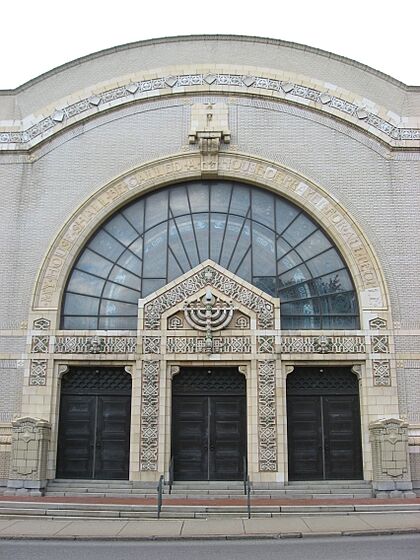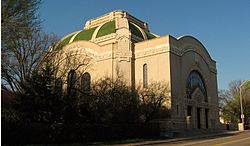Rodef Shalom Congregation facts for kids
Quick facts for kids Rodef Shalom Congregation |
|
|---|---|
|
Hebrew: רודף שלום
|
|

Rodef Shalom's celebrated façade
|
|
| Religion | |
| Affiliation | Reform Judaism |
| Ecclesiastical or organizational status | Synagogue |
| Leadership | Rabbi Sharyn H. Henry |
| Status | Active |
| Location | |
| Location | 4905 Fifth Avenue, Pittsburgh, Pennsylvania |
| Country | United States |
| Architecture | |
| Architect(s) |
|
| Architectural type | Synagogue |
| Architectural style | Beaux-Arts |
| Date established | 1856 (as a congregation) |
| Completed | 1906 |
| Construction cost | $250,000 |
| Specifications | |
| Capacity | 1,200 worshippers |
| Dome(s) | One |
| Dome dia. (outer) | 90 feet (27 m) |
Rodef Shalom Congregation is a historic synagogue in Pittsburgh, Pennsylvania. Its name means "Pursuer of Peace" in Hebrew. This beautiful building was designed by architect Henry Hornbostel. It is known for its Beaux-Arts style.
The synagogue is located on Fifth Avenue, between the Oakland and Shadyside neighborhoods. The congregation, Rodef Shalom, started in 1856. It is the oldest Jewish congregation in Western Pennsylvania. It is also the largest Reform Jewish group in the area. On the synagogue grounds, you can find the Rodef Shalom Biblical Botanical Garden.
The synagogue building became a part of the National Register of Historic Places on November 5, 1979. It was also named a Pittsburgh Historic Landmark in 2022.
Contents
A Look at Rodef Shalom's Past
In 1847, a group of Jewish people in Pittsburgh created a burial society. They called it Bes Almon, which means "Mourners’ House." They bought land on Troy Hill for a cemetery.
How the Congregation Began
By 1848, this group rented a room downtown. They formed a congregation called Shaare Shemayim, meaning "Gate of Heaven." At first, they followed Orthodox Judaism.
The group's official paper, from November 9, 1856, stated their main goals. They wanted to help religion grow. They also wanted to start a good school. This school would teach young people about the Hebrew religion and other subjects.
Over the next eight years, some members left to form new groups. But they always came back. In 1860, the groups joined together again. They took the name Rodef Shalom. At that time, they had 35 families and 50 children in their school.
The congregation soon needed a bigger space. So, they started building their own synagogue in 1861. Architect Charles Bartberger designed the first temple. It was built on Hancock Street (now Eighth Street) in downtown Pittsburgh. The building opened on March 20, 1862.
Becoming a Reform Synagogue
In 1862, the first Jewish confirmation in Pittsburgh happened here. Six girls and one boy took part.
In 1863, Isaac Mayer Wise visited Pittsburgh. He was a founder of Reform Judaism in America. His visit had a big effect. Soon after, the congregation voted to use some Reform practices. This included using the Reform prayer book. Not everyone liked this change. Some members left and formed the Tree of Life Synagogue.
The change to full Reform practices happened slowly. Over time, services became shorter. Women and men began to sit together. An organ was also installed. Music was very important to Rodef Shalom even then. Their choir was known as "one of the best in the country."
The use of English in services also took time. By 1874, men no longer had to wear a hat or yarmulke. The congregation also joined the Union of American Hebrew Congregations.
Big changes happened for Rodef Shalom in 1885. The congregation hosted a meeting of rabbis from across the country. This meeting created the "Pittsburgh Platform." It said that Judaism was a religion, not a nation. It also said the Bible was a guide for good behavior. It stated that American Jews did not have to keep kosher food rules. This platform guided Reform Judaism in North America until 1937. It also caused a big split between different Jewish groups.
The 20th Century and Growth
J. Leonard Levy became Rodef Shalom's Rabbi in 1901. He was a strong leader. Rabbi Levy worked to improve understanding between different faiths. He started an international peace group. He also preached at both Sabbath and Sunday services.
In 1909, President William Howard Taft visited Rodef Shalom. He spoke at the synagogue on May 29. This was the first time a sitting U.S. president spoke in a synagogue.
During Rabbi Levy's time, Rodef Shalom grew a lot. The number of families nearly tripled. Pittsburgh was changing, and many Jewish families moved to new neighborhoods. These included Oakland, Shadyside, and East Liberty.
The original temple building was torn down in 1900. A new, larger building, designed by Charles Bickel, replaced it. This new building opened in 1901. But by 1904, the congregation had already outgrown this space too.
Leaders decided to move the synagogue to a new area. They saw Oakland, Shadyside, and Squirrel Hill as new centers of the city. Rodef Shalom sold its building and bought land near Morewood and Fifth avenues.
Samuel H. Goldenson became the Rabbi in 1918. He made more changes to Reform practices. He convinced members to give up their private pews. Instead, seats were open to everyone. This decision brought many more members to the synagogue.
Solomon B. Freehof became Rabbi in 1934. He gave regular sermons and wrote many books. He also updated the Union Prayer Book. He was president of important Jewish organizations. His wife, Lillian, wrote plays and novels. She also organized Braille services.
The Religious School added the Levy Hall auditorium and the Cohen Chapel in 1938. A large social hall, named for Dr. Freehof, was built in 1956. An addition was also built at the back of the building. This provided an entrance from the parking lot. Rodef Shalom also helped create new Reform congregations. These included Temple Sinai, Temple Emanuel, and Temple David.
Dr. Walter Jacob became Rabbi in 1966. He had been Freehof's assistant since 1955. Membership reached its highest point in the early 1960s. Dr. Jacob founded the Freehof Institute of Progressive Halakhah. He and his wife, Irene, started the Biblical Botanical Garden at Rodef Shalom in 1986. Dr. Jacob is now Rabbi Emeritus of Rodef Shalom. He helped create Abraham Geiger College in Germany. This was the first rabbinic training college there since the Holocaust.
Rodef Shalom in the 21st Century
Dr. Mark Staitman served as Rabbi from 1997 to 2003. He was known for his work with Jewish people in the Soviet Union.
Rabbi Aaron Bisno became the senior rabbi after Dr. Staitman. He left his position in 2022 due to workplace concerns.
Rabbi Sharon Henry joined the congregation in 1999. She became the senior Rabbi in 2022 and retired in 2025.
From 2000 to 2003, other parts of the building were updated. This made them more modern and easier for people with disabilities to use. A new covered entrance from the parking lot was also added.
On October 30, 2018, Rodef Shalom hosted a memorial service. This service was for victims of the Tree of Life Synagogue shooting. Members of the Pittsburgh Steelers attended.
In December 2023, Rodef Shalom and Temple Sinai announced plans to work more closely. On June 8, 2025, both congregations approved a plan to unite. They will form a new congregation at Rodef Shalom's current building.
The Synagogue's Design
A design contest was held for the new synagogue. Henry Hornbostel won the competition. He was the architect chosen by Andrew Carnegie for Carnegie Institute of Technology. Hornbostel's Beaux-Arts style mixed old and new ideas.
The building has a special double dome. It is 90 feet (27 meters) across. It was built without steel. Instead, it used a Spanish style called the Catalan vault.
For the outside, Hornbostel chose local yellow brick. He added colorful terra cotta decorations. The design included four stained glass windows by William Willet. These windows were saved from the 1901 building. There is also a large stained glass skylight in the dome. Another stained glass window is above the Fifth Avenue entrance.
They installed a 1907 Kimball organ. It is the largest of its kind still in use. The building can seat over 900 people on the first floor. Another 300 can sit in the balcony. The building was finished in 1907. It cost $250,000 to build.
Famous Members
- Edgar J. Kaufmann: A businessman who owned Kaufmann's Department Store. He also asked for the famous Fallingwater house to be built.
- Jonas Salk: A scientist who developed one of the first successful polio vaccines.



